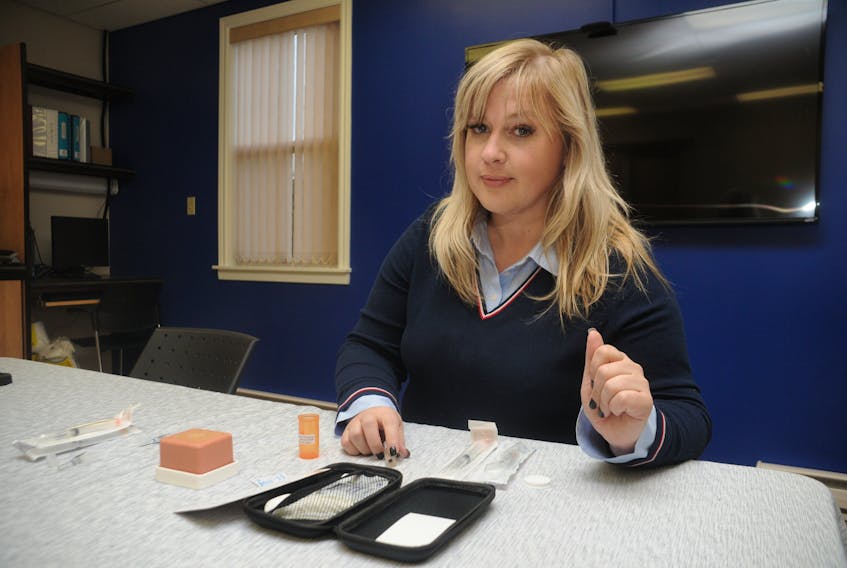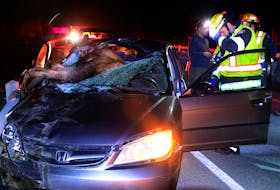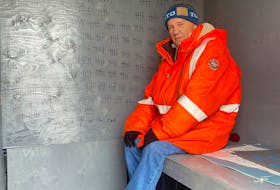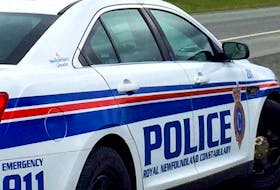ST. JOHN'S, N.L. — Jane Henderson deals with a lot of data in her job as a harm reduction consultant with Eastern Health's Opioid Dependence Treatment Centre of Excellence in St. John's.
But taking into account the seriousness of her work, she always remains aware these are not merely numbers she's dealing with.
"I always go over numbers — like we've had 10 deaths in 2018. But people need to really understand that's 10 people. That's 10 people that had families and homes and died very tragically, and we always have to keep in mind that context."
Henderson was part of a St. John's harm reduction group deeply involved in the initial distribution of naloxone kits, one of the key components to the ongoing battle in Newfoundland and Labrador and elsewhere in the world against opioid overdoses. In recent years, fentanyl use has been identified as a primary drug of concern, given its tendency to cause fatal overdoses.
Naloxone saves lives by reversing the effects of opioid overdoses. Almost three years ago to this day, distribution commenced at 52 sites in Newfoundland and Labrador for take-home kits, including Safe Works Access Program satellite sites that also handle needle exchanges, youth and adult correctional facilities and regional health authorities.
"You've got to recognize that naloxone kits are a nice way of giving a number to an approach to a problem that doesn't really have a single simple fix," Health Minister John Haggie told The Telegram. "The key around naloxone kits was to have them out early, before we did a lot of the other things, because they were a very tangible way of managing what we were concerned about at the time, which was the invasion of fentanyl into the market in Newfoundland and Labrador."

The numbers
There were initially 1,200 kits distributed and an additional 5,900 have been purchased since then (the total cost including tax for those kits is just under $241,000 according to information received through an access to information request), and the number of sites with kits has grown to 111.
Almost 3,500 people were trained to administer naloxone and 3,155 kits distributed as of Sept. 30. Of those trained, almost 82 per cent were based in the Eastern Health region (the percentage of kits distributed to that region was almost identical.)
At least 153 people returned to request replacement kits, with 64 of those people indicating the first kit was used to treat a suspected overdose. According to Henderson, it's widely estimated that for each officially reported overdose there's an additional 10-15 unreported ones.
The take-home program is for anyone who may come in contact with someone at risk of overdosing on an opioid (in situations where a naloxone kit must be used, the first step is always to call 911.)
Henderson told The Telegram naloxone kits could help people using a variety of street drugs, including cocaine, as it's possible any number of those drugs may contain fentanyl, unbeknownst to the person using them.
"It's not the end all, be all," Henderson cautioned with regards to the kits. "It's part of a more comprehensive program."
Preventative measures
On the preventative side, harm reduction specialists like Henderson encourage users not to take the drug alone — approximately half of all users do so, she added.
"We're trying to really get in to that community that it's best not to use alone, because you can't administer naloxone yourself."
Henderson said it is also good to know who you're buying the drugs from and to do a "test hit" to ensure there's nothing to suggest it is somehow tainted. Workers in the harm reduction community are trying to educate people to be aware of situations where their personal level of tolerance towards a drug may be lower than usual (for example, when they're coming out of rehab or taking other drugs or medication.)
"We recommend they do not mix drugs, because opioids don't go well with certain other drugs."
"We recommend they do not mix drugs, because opioids don't go well with certain other drugs." — Jane Henderson
On helping people with opioid addiction, Henderson said Eastern Health is providing "very rapid access" to opioid dependence treatment services.
"Years previous, I think there was a very considerable wait list for someone who was looking to get on methadone, Suboxone treatment," she said.
Depending on the time of day or what day in the week it is, Henderson's office can get people started on treatment that day or within 24-48 hours. Doorways Walk-In Clinic is also close by and provides immediate access to counsellors.
"It's been a lot of good people doing a lot of good work, so we're super proud of that," she said. "And I think there's a bit of a myth that there's a wait list still."
To find out more about how to access a take-home naloxone kit, call the Newfoundland and Labrador 811 Healthline.
They will direct callers to the nearest site to access a kit.
Legislative help
At a legislative level, two years ago government created a new law for prescription monitoring that requires doctors to review a patient's complete medical history before writing a prescription for an opioid. Monitoring powers were also developed to help identify anyone potentially overprescribing drugs. This measure's intention was to reduce inappropriate prescribing.
"We were a little different than say Vancouver or Alberta, because the drugs we were seeing in circulation were in actual fact real drugs in the sense they had a drug identification number, they were guaranteed pure ... But that had driven a real problem," Haggie said, adding that in light of a reduction in the amount of prescription opioids on the market, government knew it would need to increase access to addiction services and counselling. The number of opioid dependence treatment prescription options available in Newfoundland and Labrador has also increased considerably over the last three years, rising from over 20 to just shy of 100 today.
"We're very pleased with that, and we're not going to stop there either," Haggie said.
[email protected]
Twitter: @CBNAndrew









